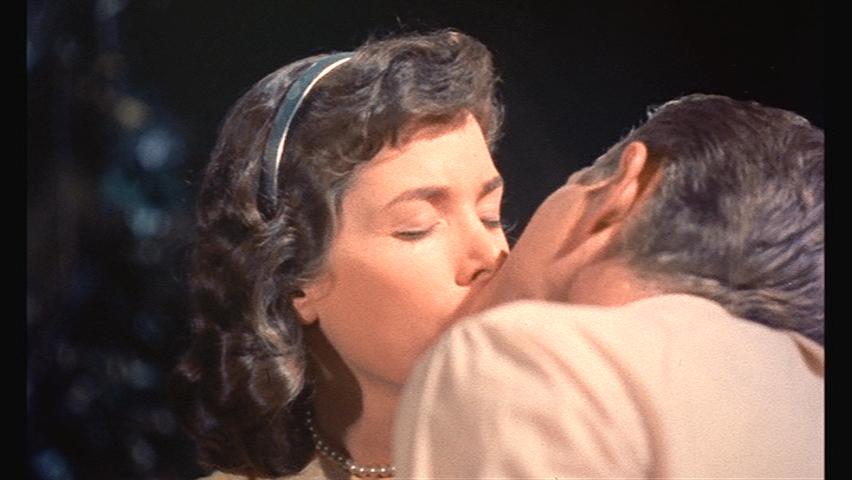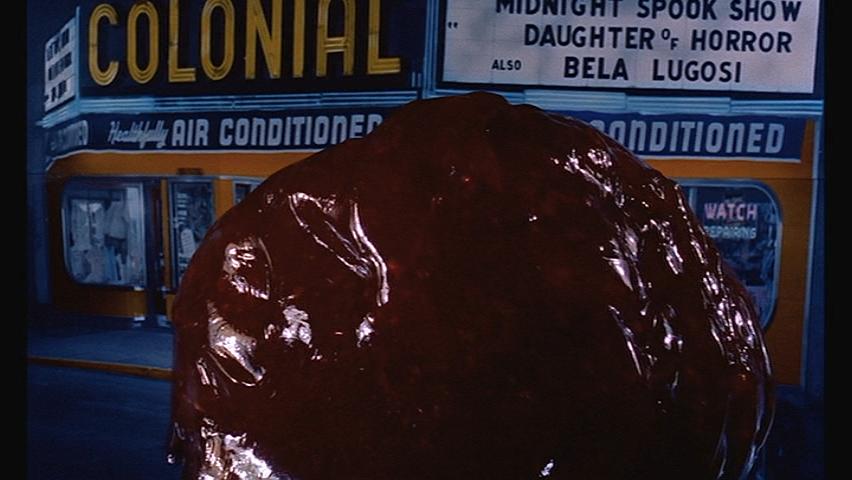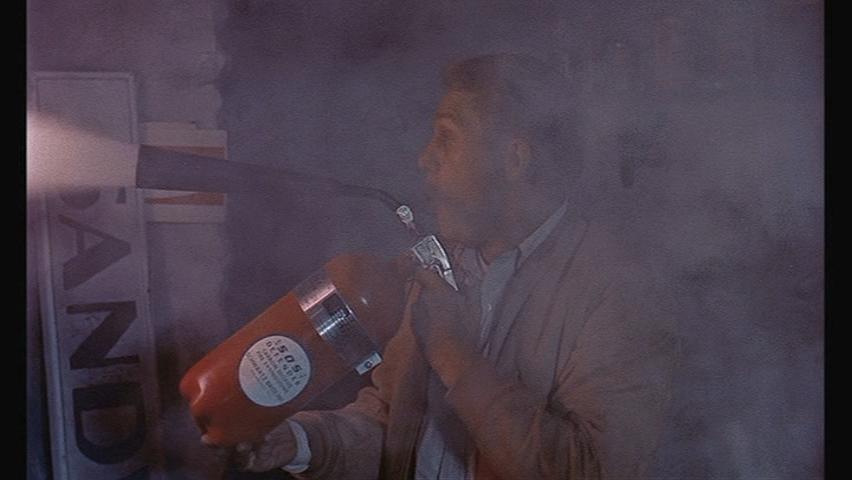"Wagner's music," said Mark Twain, "is better than it sounds." You could say something like that about this classic '50s horror movie. It's better than it has any right to be.
Opening shot: Steve Andrews (Steve McQueen, a 27-year old made up to play a thoughtful teenager) is with his girl Jane Martin (Aneta Corsault) in his convertible on a country road under the stars. A shooting star he says gives him the right to kiss her. She says this is just part of his "line." But he insists that he comes out here to see shooting stars that he can't see in town. Can she trust him? Is she special? Has he brought other girls up to this deserted spot to look at a starry sky? He protests that he hasn't, and she accedes. "Well, maybe I'm crazy but I believe you."
A particularly loud shooting star, however, has brought from outer space—THE BLOB! Its first victim is an old man who lives out in isolation. Poking at what has fallen from the sky, some of its mysterious substance crawls onto his hand, and he can't get it off. Steve and Jane take him to the town doctor, and the doctor and his nurse are the next prey. Then the Blob, now bigger and red with the blood of its victims, engulfs a garage mechanic who had been planning on going on a drunken fishing trip. By this time, Steve has alerted the police. The bad cop (feeling he is not getting his deserts for his Korean War service) angrily dismisses the frivolous "kids." The chief, wiser, takes the matter more seriously, but his investigations lead nowhere.
From the garage mechanic, the film goes on to the largely teen audience at Dementia, a midnight "spook movie" (like this one). The monster enters the projection booth, engulfs the operator, and oozes menacingly through the apertures through which the film is projected. The screaming audience flees into the streets. The police chief finally realizes that something is going seriously wrong. Meanwhile, Steve has rounded up a bunch of other teenagers, and they have made a sufficient racket to gather a crowd downtown. Steve warns them, the chief warns them, but of course The Blob descends. Steve, his girl, her little brother (an insufferable Hollywood child), a cook, and a waitress are trapped in a diner which the now-huge Blob envelops. Finally, Steve arrives at an answer to what will kill the Blob. This being a teenage movie, the solution involves the high school. Steve telephones it out to the chief, and they are all rescued.
This movie is a classic example of what I called in a long-ago essay for the Atlantic "The Good Bad Movie." This movie is really terrible. It was shot on a tiny budget at locations and a little studio in Chester Springs, PA, where the director specialized in 16 mm. religious and educational shorts. The acting is stiff; most of the players came from a nearby regional theater and acting school. The lighting is amateurish: in the night scenes, faces are bright as day. (Slow film, the producer has explained.) The editing is remarkably slow-paced, and the dialogue is full of clichés. Even the color looks fake. All of this is much in the manner of the many low-budget horror and sci-fi movies made for the drive-in trade during the McCarthy decade of the 1950s.
Pop culture interpreters see these '50s horror movies as projections of various fears of the time: juvenile delinquents, communism, atom bombs, even science itself. Thus the Blob could stand for the menace of Soviet power. It is, after all, red. Or it could be a symbol for dangerous, sexual teenagers. Red is the color of passion, and it is controlled by cold—a cold shower? As Robin Wood pithily put it, "Two teenagers kiss—enter the Blob." The movie was made—and interpreted—at the beginning of the great stretching-out of adolescence promoted after World War II by the advertising and entertainment industries. Yet something about this movie has kept it alive in popular culture long after we have replaced those '50s fears with new ones.
This is also a teenage movie, explicitly modeled (according to its producer, Jack H. Harris) on the highly successful James Dean vehicle, Rebel without a Cause (1955), one of a number of '50s movies sympathizing with "delinquent" youth. Such movies dealt with fears of teenagers by showing their good side. As such the film explicitly develops a theme of adolescents being trusted or not trusted by adults. There is the Bad Father (the high school principal!) who automatically assumes that the teenagers are up to no good. There is the Good Father who calmly says, we'll work this out in the morning. There is the Bad Cop who automatically assumes that teenagers need to be punished. There is the Good Cop who takes teenagers seriously and forgivingly. In general, the ordinary adults don't believe "the kids." (Like chaste Jane in the opening scene.) The few who do trust them form the nobility of the movie. This is all quite, even too, explicit.
This is a "good bad movie." Threaded onto the conventional horror plot and the idea of the teenager as victim are a series of details that, once you catch on to them, show a curious but interesting pattern. The film has a series of small episodes that, if one pays attention to them, make this movie a much richer experience than it ought to be. Steve and Jane were out in the woods looking at the stars and necking when the shooting star streaked across the sky—escaped from the town and their parents. The first victim lives "off the grid," away from other humans. The doctor was trying to go to a convention elsewhere. The mechanic was planning a drunken fishing trip away. All these people were trying to escape, none more so than the movie audience at the horror film (like us?). The movie projectionist was reading a book, not watching the movie he was screening. Even one of the cops whiles away his empty hours at work by playing long-distance chess with a cop in the next town.
Escape from what? These escapes were all planned before the Blob bubbled onto the scene, prompting far more urgent efforts at escape.
What is this Blob? Just some silicone dyed red and slathered on a weather balloon. But it is the ultimate consumer, absorbing everything that it can grab onto. (With this theme, it foreshadows the flesh-consuming zombies of George Romero's Night of the Living Dead and its sequels.)
For me, now, this thing that consumes everything, the thing that nothing can destroy, the thing that its victims—indeed, all the characters— are trying to escape from, is ordinary life, the tedium of job, family, neighbors, and small town society. It seems to me that what all the characters are trying to escape from, basically, is just growing up. They all, like Jane in the opening scene of the movie, want to be something special, and they're not. No wonder in the final, ultimate danger in this film the Blob is trying to swallow people in a diner. And those people consist of a man, Steve, defending the woman he loves and a child, the nuclear family, and the diner owner and a worker, the essence of job and business and consumption. Together, these five make up the essence of our adult society. And the Blob wants to absorb them.
Ultimately, then, I think we are seeing a movie about the great virtue of teenagery, the fact that it is precisely not adult life. As in the drag race early in the movie, teenagery drives backwards and on the wrong side of the road—away from the supposedly right way of doing things, the conventional, boring, grown-up way. Instead, life for the "kids" is fun, risk, entertainment, and sex. Life is altogether different for them from life for their parents and for the police.
Is that why The Blob has lasted so long in the affections of moviegoers? Is that why every year film buffs turn up at Phoenixville, PA, to celebrate this silly little movie? Because it is an antidote to the feeling that we all have sometimes that we are being eaten alive by our jobs, our marriages, our responsibilities? (I remember a university president grumbling that his job was like "being nibbled to death by ducks.") We wish, like the "kids" in this movie, just to have fun—to consume life and the things of this world. Yet all too often we feel consumed by them. And perhaps this feeling builds on our fantasies early in childhood about our mouths. They consume. They are sources of both pleasure and danger. Remember that this film starts with a wish and a kiss.



